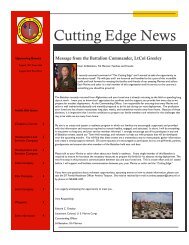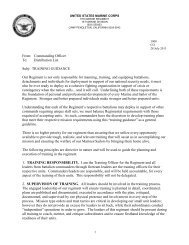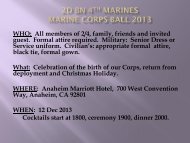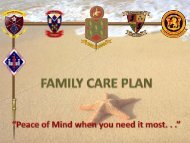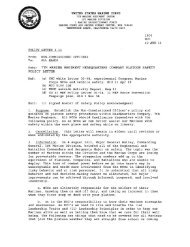June Newsletter - 1st Marine Division - Marine Corps
June Newsletter - 1st Marine Division - Marine Corps
June Newsletter - 1st Marine Division - Marine Corps
You also want an ePaper? Increase the reach of your titles
YUMPU automatically turns print PDFs into web optimized ePapers that Google loves.
Vol. 2 Issue 6grizzly gouge PAGE 6Spouses’ CornerHow well do you do social media?By Ingrid BairstowAt a recent volunteer training eventI watched a YouTube video about socialmedia that stunned and amazedme.Let me first say that I am not antisocialmedia (which includes anytype of electronic interaction, such asFacebook, Twitter, YouTube, LinkedIn,blogs, etc). Like so many millionsof others, I appreciate the instantaneousnessof Facebook especiallysharing information and photos withfriends and family all over the world.It’s especially useful avoiding trips tothe post office, printing individual picturesand actually paying postage (rememberthose days?).In a short video, Eric Qualman, abusinessman and expert on socialmedia presented the following tidbitsof information, also published in hisbook, Socialnomics.· Facebook tops Google forweekly traffic in the United States.· Social media is the #1 activityon the Web.· To reach an audience of 50million, it took radio 38 years - TV 13years - the internet 3 years. In lessthan one year, Facebook had 200 millionusers!· In fact in terms of population,if Facebook were a country, it wouldthe third largest in the world, followingChina and India.Qualman’s research is obviouslygeared for the businesses that areperhaps reluctant to enter the modernworld and social media. The numbershe lists are compelling.“We don’t have a choice on whetherwe do social media or not, the questionis how well we do it,” he states.That’s absolutely true for the businessworld – and same goes for theindividual person like you or I. Butas an individual using social media,how “well we do it” primarily dependson the privacy and safety of the informationwe are sharing with more than900 million people – that’s the totalnumber of active monthly Facebookusers as of March 2012. Over 80%of them are outside the US and Canada!(Taken directly from Facebook’sNewsroom online)Remember your mother’s adviceabout not talking to strangers? Sheprobably believed strangers were notlikely to have your safety as their toppriority. Social media has us not only‘talking’ to strangers, but telling themall about our lives – which school wewent to, what our favorite movies areand the state where we grew up, notto mention what we, our servicememberspouse and our children look likein all those great pictures!Unfortunately, I have not found apresentation on privacy concerns andhow easy it is to access informationposted on social media sites. However,anyone who has listened to anoperational security brief has a basicidea about not sharing deploymentdata on social media sites. Yet, I seeit all the time—an innocent post froma wife that is sad her husband is leavingfor 12 months (I’m guilty) and ofcourse the updates as homecomingsapproaches.The YouTube presentation openedmy eyes to the true extent that socialmedia has and continues to changeour world. It also made me more paranoidabout what I am sharing with allthose people! Here are some waysyou can at least try to keep your informationa little more private:· ALWAYS check privacy settingsand account settings regularly.Facebook is continually developingIngrid Bairstow is the wife ofRCT-5 Operations Officer, Lt.Col. Timothy Bairstownew settings with little or no notice inadvance.· Don’t post anything you don’twant ‘someone dangerous’ to knowabout you or your family. I deleted myhometown, high school and college aswell as family members. Don’t forgetabout dates and places where yourmilitary family member may be!· Listen to the news and be awareof new laws and regulations regardingsocial media.· If you have kids, monitor whatthey write and keep them educatedabout some of the dangers of postingtoo much information on their FacebookWall. Use the private messagefunction as much as possible.I hope you will go and see the fourminutevideo yourself—bet you’ll findour new reality startling and perhapsa little disconcerting as I did. KimMerkel will also post a link to the videoon the RCT-5 Facebook page.Here is the link to “The Social MediaRevolution 2012.”
Vol. 2 Issue 6grizzly gouge Page 9Afghan soldiers with combat support kandak learntrauma care techniquesStory and photos By Cpl. Anthony Ward Jr.COMBAT OUTPOST FIDDLER’S GREEN, Afghanistan –The Combat Support Advisory Team is tasked with advisingthe Afghan National Army’s 4th Kandak, <strong>1st</strong> Brigade, 215th<strong>Corps</strong>, on the many different aspects of combat support operations.One key area in the development of ANA combat supportcapabilities is the basic combat life saving skills of Afghansoldiers, which enable them to provide immediate care to casualtieson the battlefield.As the new CSAT takes the reins from their predecessors,new teachers are teaching new skills.“The old team taught them a whole lot of advanced medicaltraining,” said U.S. Navy Seaman Taqkari Johnson, acorpsman with the CSAT. “I’m going to go in and fine tunethe basic skills for treating trauma, shock and stuff like that.”“It’s good to know the medications and all the advancedstuff … but it all boils down to knowing the basics,” addedJohnson. “Right now they’re not seeing a bunch of fevers andcolds, they’re seeing a bunch of IEDs and trauma cases likethat.”With trauma care in mind, Johnson began a medical class toinstruct ANA soldiers on the proper use of tourniquets, pressuredressings and other basic combat lifesaving tools.The course was attended by nine soldiers, with a mixed level ofskills in combat care. At the beginning of the class, each soldierwas asked about themselves and what they learned up to thispoint in combat casualty care. Once introductions were outthe way, Johnson dove into the course material.“I taught them the basics of what a tourniquet is,” said Johnson.“When to use a tourniquet, where to apply it and how muchpressure to apply. “COMBAT OUTPOST FIDDLER’S GREEN, Afghanistan – Afghan National Army soldierswith 4th Kandak, <strong>1st</strong> Brigade, 215th <strong>Corps</strong>, watch attentively as Staff Sgt. Roy Lackey appliesa tourniquet to U.S. Navy Seaman Taqkari Johnson during a combat lifesaver coursehere, May 7, 2012. With trauma care in mind, Johnson, a corpsman with the Combat SupportAdvisory Team, instructed ANA soldiers on the proper use of tourniquets, pressuredressings and other basic combat lifesaving tools.COMBAT OUTPOST FIDDLER’S GREEN, Afghanistan – An Afghan National Army soldier with4th Kandak, <strong>1st</strong> Brigade, 215th <strong>Corps</strong>, applies a tourniquet to the leg of notional casualty duringa combat lifesaver course here, May 7, 2012. The course was taught by U.S. Navy SeamanTaqkari Johnson, a corpsman with the Combat Support Advisory Team, comprised mainly of<strong>Marine</strong>s from 11th <strong>Marine</strong> Regiment. With trauma care in mind, Johnson instructed ANA soldierson the proper use of tourniquets, pressure dressings and other basic combat lifesaving tools.The first day of the course ended with a practical applicationdrill.Two soldiers would lay on the ground with a notional injury toan arm, leg or multiple limbs. Tourniquets were given to anotherpair of soldiers waiting about 50 feet away to provide care to thenotional casualties.The two soldiers tasked as care providers would race down totheir notional casualty, assess his injuries and apply the tourniquetas necessary to treat the simulated wounds.The soldiers were all smiles at the conclusion of the first day’straining, giving positive feedback to their corpsman advisor.“It’s very important for us to learn these skills. If some of oursoldiers or some of our friends get injured we can help thoseguys and save lives, “ said Shah Wali, a soldier with EngineerTolai, 4/1/215. “We are always in combat and [there is] always achance for us to get injured.”“We want to do as much training as possible so we can teachit to the other soldiers,” Wali added.Equipping as many soldiers as possible with the knowledge topreserve a life and limb on the battlefield will aid in the continueddevelopment the ANA as they assume responsibility for securityacross southern Helmand.Editor’s Note: The Combat Support Advisory Team is currentlyoperating in direct support of Regimental Combat Team 5, <strong>1st</strong><strong>Marine</strong> <strong>Division</strong> (Forward), which works in partnership with theAfghan National Security Forces and the Government of the IslamicRepublic of Afghanistan to conduct counterinsurgency operations.The Unit is dedicated to securing the Afghan people,defeating insurgent forces and enabling ANSF assumption ofsecurity responsibilities within its area of operations in order tosupport the expansion of stability, development and legitimategovernance.
grizzly gougeVol. 2 Issue 6Page10KHAN NESHIN DISTRICT, Afghanistan – U.S. <strong>Marine</strong> Gunnery Sgt. Carlos Aguilera, a platoonsergeant with Echo Company, <strong>1st</strong> Light Armored Battalion, and 31-year-old native of LosAngeles, works out with Ahlim, a linguist with Echo Co., using portable suspension trainingequipment during an overnight post here, April 26, 2012. Due to the high operational temporequired of Echo Co., Aguilera and his fellow <strong>Marine</strong>s have spent nearly their entire deploymenton the road. After a rigorous day of patrolling or holding a vehicle checkpoint, the Echo <strong>Marine</strong>sutilize their mobile gym to maintain the <strong>Marine</strong> <strong>Corps</strong> standard of fitness.Photo by (Cpl. AlfredV. Lopez)DURZAY, Afghanistan — U.S. Navy Petty Officer 2nd Class Ronald Valdez (left), a corpsman with <strong>1st</strong> Platoon,India Company, 3rd Battalion, 3rd <strong>Marine</strong> Regiment, and 30-year-old native of Waipahu, Hawaii, extends ahelping hand to <strong>Marine</strong> Lance Cpl. Patrick Mireles, a team leader and 23-year-old native of Austin, Texas, asMireles jumps a stream during a security patrol here, April 30, 2012. After six combat deployments to Afghanistanand Iraq since 2004, they’re finally coming home. During their seven months in Garmsir, they advised anddeveloped Afghan forces preparing to take the lead in providing security for the district. As the Afghan forcesgrew in number and capability, commerce expanded and successful district community council elections wereheld in April 2012. ‘America’s Battalion’ transferred control of coalition positions in Garmsir to Kilo Co., 3rd Bn.,8th <strong>Marine</strong>s, May 14. (Photo by Cpl. Reece Lodder)COMBAT OUTPOST DULUTH, Afghanistan – Yeager, an improvised explosive device detection dog, lies in front of a battlefield cross as Staff Sgt. Derick Clark, a kennel supervisor with Headquartersand Service Company, 2nd Battalion, 9th <strong>Marine</strong> Regiment, and 26-year-old native of Hillsdale, Mich., and Chief Warrant Officer 2 Michael Dale Reeves, a kennel officer in charge with 2nd Bn., 9th<strong>Marine</strong>s and 41-year-old native of Mt. Pleasant, S.C., observe a moment of silence in honor of Lance Cpl. Abraham Tarwoe, a dog handler and mortarman who served with Weapons Company, 2ndBn., 9th <strong>Marine</strong>s, during a memorial service here, April 22, 2012. Tarwoe, who became Yeager’s handler in July 2011, was killed in action during a dismounted patrol in support of combat operations inHelmand province’s Marjah district, April 12. Tarwoe’s fellow <strong>Marine</strong>s remember him for his contagious laughter and smile, and his unfaltering courage on the battlefield. (Photo by Cpl. Alfred V. Lopez)





